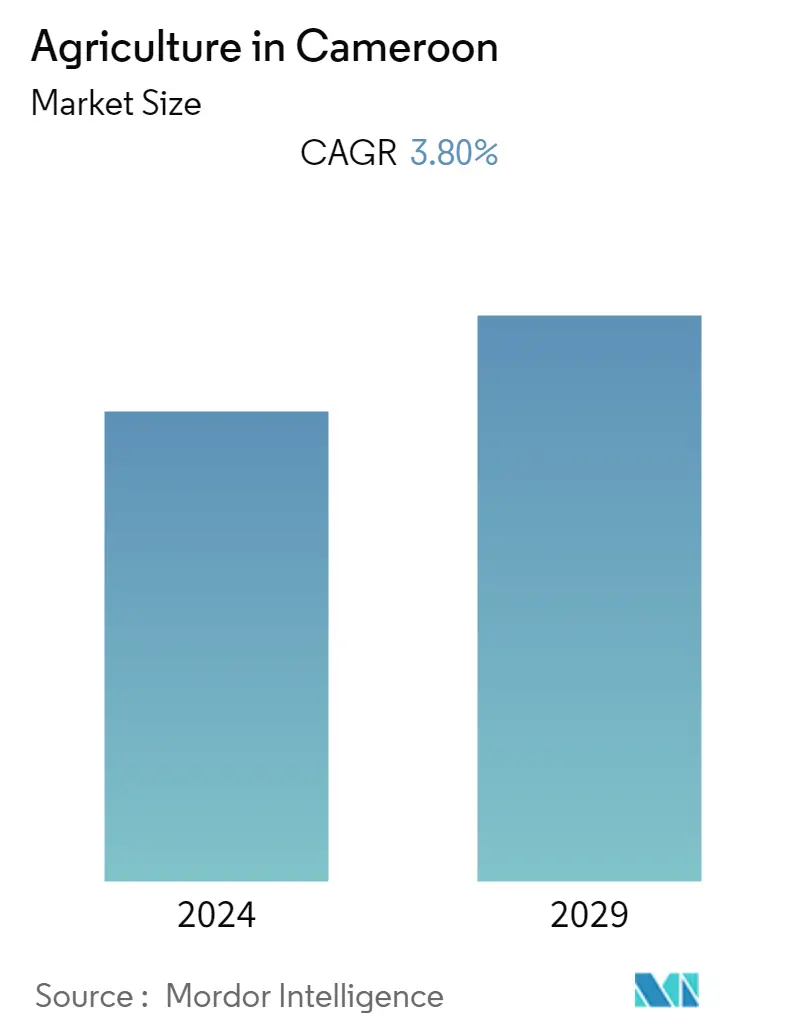Market Size of Agriculture in Cameroon

| Study Period | 2019 - 2029 |
| Base Year For Estimation | 2023 |
| Forecast Data Period | 2024 - 2029 |
| Historical Data Period | 2019 - 2022 |
| CAGR | 3.80 % |
Major Players*Disclaimer: Major Players sorted in no particular order |
Cameroon Agriculture Market Analysis
The Agriculture Market in Cameroon is estimated at USD 11.26 billion in 2023, and is expected to reach USD 13.57 billion by 2028, growing at a CAGR of 3.80% during the forecast period (2023-2028).
- Agriculture in Cameroon is emerging as a promising industry, and young people are returning to the land, due to donor-funded projects, in particular, the World Bank-funded Agricultural Competitiveness Project (PACA). The main cash crops cultivated include cocoa, coffee, cotton, bananas, rubber, palm oil and kernels, and peanuts. The important food crops are plantains, cassava, corn, millet, and sugarcane.
- Cameroon is the second and sixth largest exports of cocoa beans with USD 647 million and bananas with USD 266 million, respectively. The country also produces coffee, cotton, rubber, and corn. The Cameroonian government has focused to increase production in all six crops and domestic rice production, as the sector faces increasing supply shortages.
- In Cameroon, a new project to redesign agricultural practices and food stability and project is managed by the CDVTA, Community Development Volunteers for Technical Assistance, in collaboration with the Association for Vertical Farming and aims to improve the lives of rural farmers in North West Cameroon by developing local skills and knowledge and to alleviate poverty and food insecurity in the region by helping farmers to improve crop yield, maximize income profit and protect the natural environment. In Cameroon, agriculture is vital in achieving sustainable development goals such as poverty eradication, achieving zero hunger, and ensuring food security further boost the agriculture sector in the country.
Cameroon Agriculture Industry Segmentation
The report defines agricultural products in terms of the end-users. For this report, the market scope includes only fresh agricultural produce. The Cameroonian Agriculture Market Is segmented by Cereals and Grains, Cash Crops, Fruits, and Vegetables. The Report includes the Production Analysis (Volume), Consumption Analysis (Value and Volume), Export Analysis (Value and Volume), Import Analysis (Value and Volume), and Price Trend Analysis. The report offers market sizing in value in terms of both USD million and volume in terms of metric ton.
Agriculture in Cameroon Size Summary
The agriculture sector in Cameroon is poised for significant growth, driven by various initiatives and projects aimed at enhancing agricultural practices and increasing crop yields. The industry is supported by donor-funded projects, such as the World Bank's Agricultural Competitiveness Project, which encourages youth engagement in agriculture. Cameroon is a major producer and exporter of cash crops like cocoa, coffee, and bananas, while also focusing on increasing domestic production of essential food crops to address supply shortages. Collaborative efforts by organizations like the Community Development Volunteers for Technical Assistance and the Association for Vertical Farming aim to improve the livelihoods of rural farmers by enhancing local skills and knowledge, thereby contributing to poverty alleviation and food security.
The demand for fresh fruits and vegetables is on the rise, fueled by increased health consciousness among consumers. This trend is reflected in the growing production of various fruits and vegetables, supported by projects from the World Vegetable Center and Barry Callebaut, which promote vegetable production in cocoa communities. The cereal crop market, dominated by maize, is also experiencing growth due to favorable climatic conditions and supportive government policies. Initiatives like Agri-parks and the IFAD project are expected to further boost cereal crop cultivation. The deregulation of marketing has matured the cereal crop market, allowing farmers to freely trade their produce, which is anticipated to enhance exports and benefit the agricultural market in Cameroon during the forecast period.
Agriculture in Cameroon Market Size - Table of Contents
-
1. MARKET DYNAMICS
-
1.1 Market Overview
-
1.2 Market Drivers
-
1.3 Market Restraints
-
1.4 Value Chain Analysis
-
-
2. MARKET SEGMENTATION Production Analysis (Volume), Consumption Analysis (Value and Volume), Export Analysis (Value and Volume), Import Analysis (Value and Volume), and Price Trend Analysis.
-
2.1 Cereals
-
2.2 Fruits
-
2.3 Vegetables
-
2.4 Cash Crops
-
Agriculture in Cameroon Market Size FAQs
What is the current Agriculture in Cameroon Market size?
The Agriculture in Cameroon Market is projected to register a CAGR of 3.80% during the forecast period (2024-2029)
What years does this Agriculture in Cameroon Market cover?
The report covers the Agriculture in Cameroon Market historical market size for years: 2019, 2020, 2021, 2022 and 2023. The report also forecasts the Agriculture in Cameroon Market size for years: 2024, 2025, 2026, 2027, 2028 and 2029.

